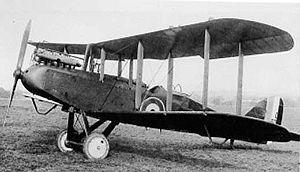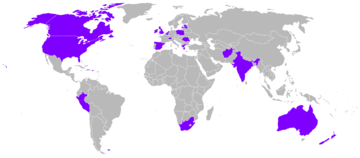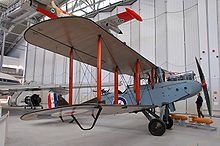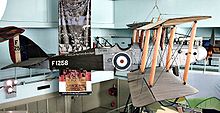Airco DH.9 Video - Picture

|
|
Airco DH.9
DH.9

Picture - Airco D.H.9
Role: Bomber
Manufacturer: Airco
Designed by: Geoffrey de Havilland
First flight: July 1917
Introduced: 1917
Retired: 1920
Primary users: Royal Air Force
RNAS, RFC.
Number built: 4091
Variants: Airco DH.9A
Airco DH.9C
Westland Walrus
The Airco DH.9 (from de Havilland 9) - also known after 1920 as the de Havilland DH.9 - was a British bomber used in the First World War. A single-engined biplane, it was a development of Airco's earlier, highly successful DH.4 and was ordered in very large numbers for Britain's Royal Flying Corps and Royal Air Force.
Its engine was unreliable, and failed to provide the expected power, giving the DH.9 poorer performance than the aircraft it was meant to replace, and resulting in heavy losses, particularly over the Western Front. The subsequently-developed DH.9A had a more powerful and reliable American Liberty L-12 engine.
Design and development
The DH.9 was designed by de Havilland for the Aircraft Manufacturing Company in 1916 as a successor to the DH.4. It used the wings and tail unit of the DH.4 but had a new fuselage. This enabled the pilot to sit closer to the gunner/observer and away from the engine and fuel tank. The other major change from the DH.4 was the choice of the promising new BHP/Galloway Adriatic engine, which was predicted to produce 300 hp (224 kW) and so give the new aircraft an adequate performance to match enemy fighters.
By this time, as a result of attacks by German bombers on London, the decision was made to almost double the size of the Royal Flying Corps, with most of the new squadrons planned to be equipped with bombers. Based on the performance estimates for the DH.9 (which were expected to surpass those of the DH.4), and the similarity to the DH.4, which meant that it would be easy to convert production over to the new aircraft, massive orders (4,630 aircraft) were placed.
The prototype (a converted DH.4) first flew at Hendon in July 1917. Unfortunately, the BHP engine proved unable to reliably deliver its expected power, with the engine being de-rated to 230 hp (186 kW) in order to improve reliability. This had a drastic effect on the aircraft's performance, especially at high altitude, with it being inferior to that of the DH.4 it was supposed to replace. This meant that the DH.9 would have to fight its way through enemy fighters, which could easily catch the DH.9 where the DH.4 could avoid many of these attacks.
While attempts were made to provide the DH.9 with an adequate engine, with aircraft being fitted with the Siddeley Puma, a lightened and supposedly more powerful version of the BHP, with the Fiat A12 engine and with a 430 hp (321 kW) Napier Lion engine, these were generally unsuccessful (although the Lion engined aircraft did set a World Altitude Record of 30,500 ft (13,900 m) on 2 January 1919) and it required redesign into the DH.9A to transform the aircraft.
Operational history

Picture -
The first deliveries were made in November 1917 to 108 Squadron RFC and first went into combat over France in March 1918 with 6 Squadron, and by July 1918, nine squadrons operational over the Western Front were using the type.
The DH.9's performance in action over the Western Front was a disaster, with heavy losses incurred, both due to its low performance, and engine failures (despite the prior de-rating of its engine). For example, between May and November 1918, two squadrons on the Western Front (Nos. 99 and 104) lost 54 shot down, and another 94 written off in accidents. The DH.9 was however more successful against the Turkish forces in the Middle East, where they faced less opposition, and it was also used extensively for coastal patrols, to try and deter the operations of U-boats.
Following the end of the First World War, DH.9s operated by 47 Squadron and 221 Squadron were sent to southern Russia in 1919 in support of the White Russian Army of General Denikin during the Russian Civil War. The last combat use by the RAF was in support of the final campaign against Mohammed Abdullah Hassan (known by the British as the "Mad Mullah") in Somalia during January-February 1920. Surprisingly, production was allowed to continue after the end of the war into 1919, with the DH.9 finally going out of service with the RAF in 1920.
Following the end of the First World War, large number of surplus DH.9s became available at low prices and the type was widely exported (including aircraft donated to Commonwealth nations as part of the Imperial Gift programme.
The South African Air Force received 48 DH.9s, and used them extensively, using them against the Rand Revolt in 1922. Several South African aircraft were re-engined with Bristol Jupiter radial engines as the M'pala, serving until 1937.
Civilian use
Because of the large number of surplus DH.9s available after the war many were used by air transport companies. They provided a useful load carrying capability and were cheap. Early air services between London, Paris and Amsterdam were operated by DH.9s owned by Aircraft Transport and Travel. A number of different conversions for civil use were carried out, both by Airco and its successor the de Havilland Aircraft Company and by other companies, such as the Aircraft Disposal Company. Some radial powered DH.9Js continued in use until 1936.
Variants
DH.9 - Revised version of the DH.4 with the pilot and observer/gunner placed closer together (3,024 production aircraft built with others built in Belgium and Spain).
DH.9A - (also referred to as the Nine-Ack) was designed for Airco by Westland Aircraft to take advantage of the 400 hp (298 kW) American Liberty L-12 engine. Apart from the new engine and slightly larger wings it was identical to the DH.9. Initially it was hoped to quickly replace the DH.9 with the new version - however a shortage of Liberty engines available to the RAF curtailed the new type's service in the First World War - and it is best known as a standard type in the postwar RAF - serving as a general purpose aircraft for several years. 2,300 DH.9As were built by ten different British companies.
DH.9B - Conversions for civilian use as three-seaters (one pilot and two passengers)
DH.9C - Conversions for civilian use as four-seaters (one pilot and three passengers)
DH.9J - Modernised and re-engined conversions using the 385 hp (287 kW) Armstrong Siddeley Jaguar III radial engine. Used by the De Havilland School of Flying.
DH.9J M'pala I - Re-engined conversions carried out by the South African Air Force. Powered by a 450 hp (336 kW) Bristol Jupiter VI radial piston engine.
M'pala II - Re-engined conversions carried out by the South African Air Force, powered by a 480 hp (358 kW) Bristol Jupiter VIII radial piston engine.
Mantis - Re-engined conversions carried out by the South African Air Force, powered by a 200 hp (149 kW) Wolseley Viper piston engine.
Handley Page HP.17 - A DH.9 experimentally fitted with slotted wings
USD-9 - DH.9s manufactured in the United States by the US Army's Engineering Division (1,415 built)
Operators
Military Operators

Picture - DH.9 operators
Afghanistan
18 aircraft, including 16 built by Duks Aircraft Works, were acquired from 1924 by the Afghan Air Force.
Australia
Royal Australian Air Force - Only one DH.9 (RAAF serial A1-28) was ever used by the RAAF from 1920 to 1929.
No. 1 Flying Training School RAAF
Belgium 18 aircraft. Canada Chile Received 20 DH.9s. Estonia
Estonian Air Force operated 13 DH.9s from 1919-33 .
India
(Part of Imperial Gift Scheme)
Greece
Royal Hellenic Naval Air Service
Kingdom of Hejaz Ireland
Irish Air Service
Irish Air Corps
Latvia Netherlands
Royal Netherlands East Indies Army Air Force operated 36 DH.9s, some of which were re-engined with Pratt & Whitney Wasp radial engine and remaining in service until 1934.
New Zealand
Three Airco DH.9s were in service with the New Zealand Permanent Air Force from 1923 to 1929. The DH.9s were used by the NZPAF as advanced training aircraft.
Peru Poland
20 DH.9 received in 1920, used during the Polish-Soviet war, until 1929.
Romania Kingdom of Spain South Africa
South African Air Force (Locally modified with Jupiter engines and given the local name Mpala).
Switzerland United Kingdom
Royal Flying Corps
Royal Naval Air Service
Royal Air Force
United States
American Expeditionary Force
United States Marine Corps
Civil Operators
Australia
Qantas
Belgium
Sabena
Denmark
Det Danske Luftfartselskab‎
Netherlands
KLM
Romania
SNNA
Kingdom of Spain
Cia Espanola del Trafico Aereo
United Kingdom
Aircraft Transport and Travel
Handley Page Transport Company
Survivors

Picture - DH.9 preserved at the Imperial War Museum Duxford
Of the thousands of DH.9s built, only a few have survived to be preserved. F1258 is displayed at the Musée de l'Air et de l'Espace in Paris, , with a second DH.9 being preserved at the South African National War Museum, while G-EAQM, the first single engined aircraft to fly from the United Kingdom to Australia is preserved in the Australian War Memorial at Canberra.
The remains of three DH.9s were discovered in India in 2000, one of which is displayed at the Imperial War Museum at Duxford, and another in the process of being restored to flying condition.
Specifications (D.H.9 (Puma Engine))

Picture - DH.9 F1258 displayed at the Musee de l'Air et de l'Espace, Paris Le Bourget
Data from The British Bomber since 1914
General characteristics
Crew: 2
Length: 30 ft 5 in (9.27 m)
Wingspan: 42 ft 4â…ť in (12.92 m)
Height: 11 ft 3˝ in (3.44 m)
Wing area: 434 ft˛ (40.3 m˛)
Empty weight: 2,360 lb (1,014 kg)
Max takeoff weight: 3,790 lb (1,723 kg)
Powerplant: 1x— Armstrong Siddeley Puma piston engine, 230 hp (172 kW)
Performance
Maximum speed: 98 kn (113 mph, 182 km/h)
Endurance: 4˝ hours
Service ceiling: 15,500 ft (4,730 m)
Climb to 10,000 ft: 18 min 30 sec
Armament
Guns: Forward firing Vickers machine gun and 1 or 2 x— Rear Lewis guns on scarff ring
Bombs: Up to 460 lb (209 kg) bombs
Related development
Airco DH.4
Airco DH.9A
Comparable aircraft
Breguet 14
Bibliography
Barnes, C.H. Handley Page Aircraft since 1907. London:Putnam, 1976. ISBN 0 370 00030 7.
Bruce, J.M. "The De Havilland D.H.9: Historic Military Aircraft: No. 12, Part I". Flight, 6 April 1956. Pages 385-388, 392.
Bruce, J.M. "The De Havilland D.H.9: Historic Military Aircraft: No. 12, Part II". Flight, 13 April 1956. Pages 422-426.
Gerdessen, F. "Estonian Air Power 1918 - 1945". Air Enthusiast No 18, April - July 1982. Pages 61-76. ISSN 0143-5450.
Jackson, A.J. British Civil Aircraft since 1919 Volume 2. London:Putnam, Second edition 1973. ISBN 0 370 10010 7.
Jackson, A.J. De Havilland Aircraft since 1909. London: Putnam, Third edition 1987. ISBN 0 85177 802 X.
Mason, Francis K. The British Bomber Since 1914. London: Putnam Aeronautical Books, 1994. ISBN 0-85177-861-5.
Winchester, Jim, ed. Bombers of the 20th Century. London: Airlife Publishing Ltd., 2003. ISBN 1-84037-386-5.
Airco DH.9 Pictures and Airco DH.9 for Sale.
Living Warbirds: The best warbirds DVD series.
Source: WikiPedia